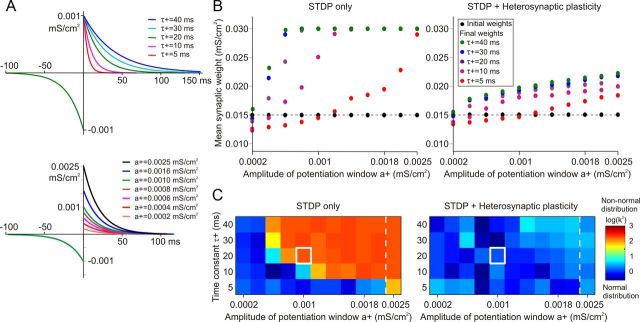Figure 8.
Heterosynaptic plasticity prevents runaway dynamics of synaptic weights over a broad range of STDP parameters. A, Examples of potentiation windows in STDP rules, illustrating the range of tested parameters. Top, STDP potentiation windows with the same maximal magnitude of potentiation a+ = 10−3 mS/cm2, but different time constants, τ+ = 5, 10, 20, 30, 40 ms. Bottom, STDP potentiation windows with the same time constant, τ+ = 20 ms, but different maximal magnitudes, a+ = 0.2 × 10−3 to a+ = 2.5 × 10−3 mS/cm2, as indicated. In this series of simulations, the depression window of STDP was kept constant (a− = 10−3 mS/cm2; τ− = 20 ms), so the range of tested parameters of potentiation window a+, τ+ covered positively biased, negatively biased, and symmetrical STDP rules. B, Each data point shows the mean synaptic weight of 100 synapses after 100 s of simulation, for different values of a+ (x-axes) and τ+ (color coded, as indicated). Black circle symbols connected by a dashed line show the mean of the initial distribution of synaptic weights that was identical in all simulations. In all simulations, presynaptic spike trains had mean rate of 1 Hz, with 0.348 ± 0.05 correlation. Left, Results after 100 s simulations with STDP only. Right, Results after 100 s simulations with heterosynaptic plasticity (as described in Fig. 3) in addition to STDP. Note that in simulations with the STDP-only model, synaptic weights were most often saturated at maximal value (0.03 mS/cm2). In contrast, in simulations with STDP and heterosynaptic plasticity, synaptic weights were not saturated. C, Each box in the grids shows the D'Agostino–Pearson K2 test for normality of synaptic weight distribution after 100 s of simulations with different STDP potentiation windows, with a+ and τ+ as indicated on the x- and y-axes. The same data as in B were used for this plot. Left, Results after 100 s simulations with STDP only. Right, Results after 100 s simulations with heterosynaptic plasticity (as described in Fig. 3) in addition to STDP. Note that in STDP-only models, distribution of synaptic weights after 100 s of simulation deviates from normal (K2 values above 50) for a broad range of a+ and τ+. In contrast, in the models with STDP and heterosynaptic plasticity, distribution of synaptic weights remained normal over the whole range of tested a+ and τ+ values.

